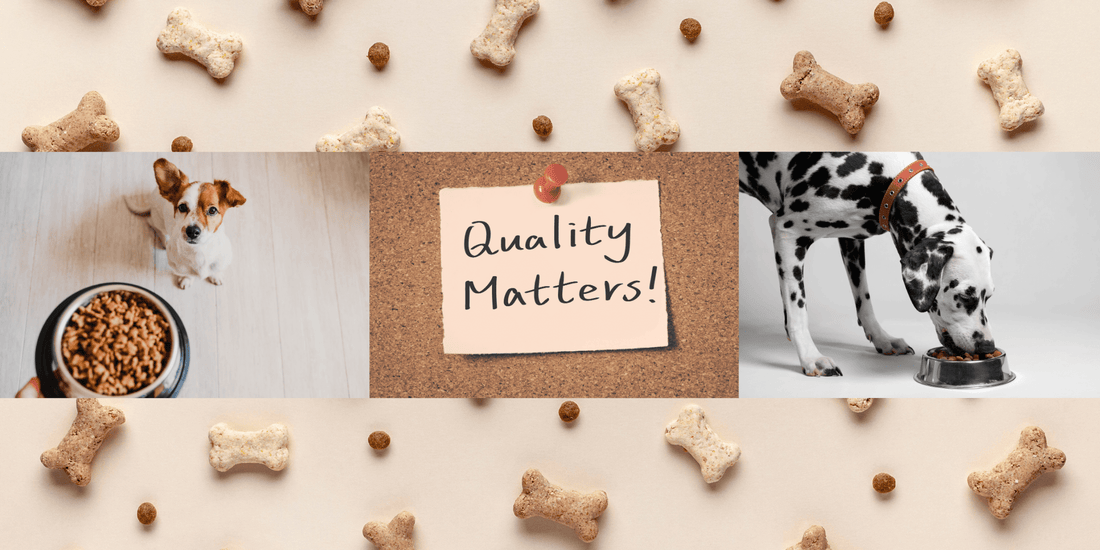How to recognize quality dog food?
When choosing food for your dog, we want the best – something that will not only fill their stomachs but also support their health, vitality and well-being throughout their lives. But with so much choice on the market, colorful packaging and misleading slogans, it can be hard to know what's really good quality.

When choosing food for your dog, we want the best – something that will not only fill their stomachs but also support their health, vitality and well-being throughout their lives. But with so much choice on the market, colorful packaging and misleading slogans, it can be hard to know what's really good quality.
This blog will help you understand what should be in a really high-quality dog food and what is better to avoid .
What MUST be in quality dog food?

Dogs are omnivores with a strong carnivorous instinct – so meat is a key part of their diet.
What we are looking for:
-
Meat as the first ingredient (e.g. chicken, beef, salmon, lamb).
-
Dehydrated meat or meat meal (meaning concentrated protein).
-
Clear indication of origin (not just “meat”, but “chicken meal”, “fresh beef”, etc.).
Why? Protein from meat builds muscle, supports the immune system, and helps with cell repair.
 Fats are a source of energy and are important for skin, coat, joints and vitamin absorption .
Fats are a source of energy and are important for skin, coat, joints and vitamin absorption .
Healthy fats:
-
salmon oil , chicken oil , or flaxseed
-
omega-3 and omega-6 fatty acids
-
EPA + DHA (especially important for the brain and joints)
 Dogs don't need a lot of carbohydrates, but in moderate amounts they are a useful source of energy .
Dogs don't need a lot of carbohydrates, but in moderate amounts they are a useful source of energy .
Good sources - alternative sources:
-
brown rice , oats , sweet potatoes , peas
-
fruits and vegetables : blueberries, apples, pumpkin, carrots
Bad sources (preferably not):
-
corn, wheat, white rice – often used as fillers
Why? Fillers like corn, wheat, white rice are often highly processed and low in fiber, vitamins, and minerals compared to alternatives. They also contain more gluten and complex starches that are harder to digest. Corn and wheat are also among the most common allergens in dogs - they can cause itching, diarrhea, ear infections, digestive problems, ...

For a balanced diet, a range of essential vitamins and minerals should be added.
Vitamins that a dog needs:
-
A, D3, E, B-complex (B1, B2, B3, B5, B6, B12), folic acid, biotin
Minerals:
-
calcium, phosphorus, zinc, iron, copper, manganese, magnesium, iodine, selenium
Important: The correct calcium:phosphorus ratio (approximately 1.2–1.5:1) is crucial for healthy bones.
 They are not necessary, but they are a sign of higher quality and bring additional benefits.
They are not necessary, but they are a sign of higher quality and bring additional benefits.
Useful accessories:
-
Glucosamine and Chondroitin – joint support
-
probiotics and prebiotics (MOS, FOS, inulin) – for healthy intestinal flora
-
Yucca schidigera – reduces stool odor
-
herbs : rosemary (antioxidant), parsley (for breath), chamomile (soothes the stomach), nettle, turmeric, dandelion, ...
What should NOT be in dog food?
1. By-products
If the ingredients list says “meat by-products” or “animal meal” without a clear definition of the source, that’s a bad sign. It’s ground up leftovers like beaks, feathers, bones, etc.
2. Artificial additives
-
dyes (Blue 2, Yellow 5/6, Red 40)
-
preservatives (BHA, BHT, ethoxyquin)
-
artificial flavors
3. Sugars and fillers
-
Sugar, molasses, corn syrup = completely unnecessary and potentially harmful.
-
Excessive amounts of grains (corn, wheat) = cheaper fillers with no nutritional value.
4. Unsaturated fats
- The source of ingredients must be clearly labeled (e.g. "chicken fat", not just "animal fat").
Tip for reading ingredients:
-
The first ingredient = the most important (it is the most) - therefore meat must be listed first!
-
Make sure the origin of the ingredients is clearly labeled (e.g. "lamb meat", not just "meat").
-
Fewer ingredients = often more natural and healthy food.
-
General rule: the shorter the list and the more ingredients you can recognize and pronounce, the better the food!
Your dog can't tell you if something isn't right for him - but you can read what you're giving him . Pay attention to the ingredients - your dog will thank you. 🐶💚
Let's look at an example of an ingredient list on quality food!


